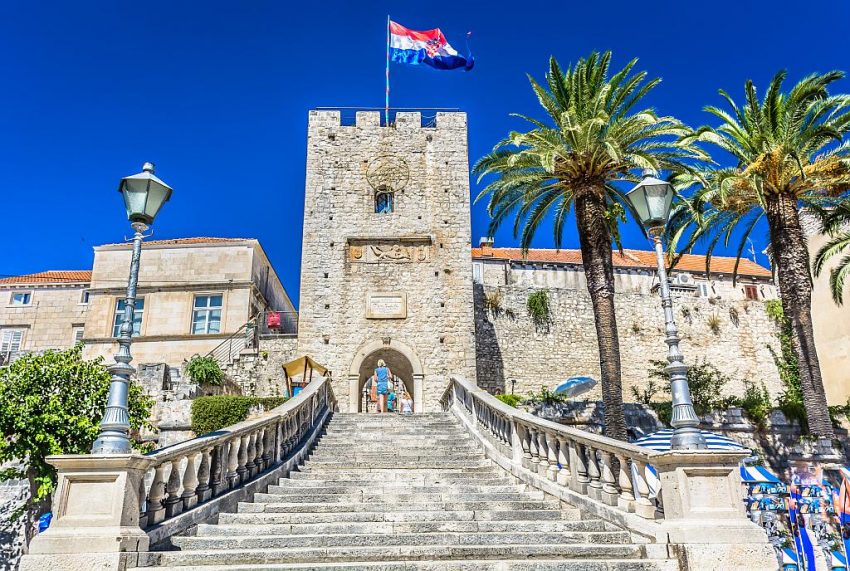The town of Korčula (Island of Korčula)
Korčula is a small fortified town located on the northeast coast of the island of Korčula. The form of this charming historic town is determined by the form of small peninsula protruding into the sea and its connection with the island was cut off by an artificial channel. Building outside the walls was strictly forbidden until the 18th century when the wooden drawbridge was replaced.

It is surrounded by the walls, built in gothic style, reinforced at the strategic points like those near the port, where major attacks were expected. The streets of the town are arranged in a herringbone pattern in order to reduce the effects of the sun and wind. The old town is the main attraction with its walls, towers, narrow streets and the wondrous architecture mainly influenced by Venetian Renaissance. Almost all town’s narrow streets are stepped, except the Charity Street, often referred as the Street of Thoughts, as one did not have to worry about the steps.


What to visit
Cathedral of St. Mark – is a Gothic-Renaissance building, built in the 15th century by Korčulan masters from local stone. Three apses witness the existence of an earlier church from the 13th century. The portal with the lions and St. Mark is the work of master Bonino from Milano. He also designed the door on the south aisle with the figure of St. Jacob. Marko Andrijić created the glorious rosette, the wreath and the belfry and the ciborium above the main altar as his masterpiece. In 1557, an organ was placed in the cathedral and in 1787 new organ was built by Vinko Klišević.

St. Michael’s Church – is located on Antun and Stjepan Radić Square, overlooking the Town Hall. During the 17th century, the church gained its baroque appearance and the small chapel dedicated to the Virgin of Consolation was built in the 19th century. The painting above the main altar is the “Virgin of Consolation” by Domenico Maggiotto from the 18th century.
Town Museum – is located in the Gabrielis Palace on the St. Mark’s square, built in the 15th century. The exhibits display a fascinating insight into the cultural and commercial milestones of Korčula from ancient times to the present. Among the most worthy exhibits are the bronze pendant of Tiziano Aspetti and the piano played by Beethoven’s close friend, Edith Streicher from early 19th century.
In the museum, there are many important presentations like the page from the Statute of the City and the Island of Korčula from 1214, the artistic imagery of the city, stamps, stone inscriptions, documents and coats of arms.

Abbey Treasury – next to the Cathedral of St. Mark and the town museum, there is the former bishop’s court (14th and 15th century) where the Abbey Treasury is held. It was set up by the abbot Ivo Matijaca and the Croatian painter Ljubo Babić back in 1954. The museum displays many precious works of art of Croatian and Venetian artists. The most important work is the polyptych “Our Lady With Child and Saints” by the Dalmatian painter Blaž Jurjev Trogiranin from 1431. In the museum, you can admire many books and documents that witness a rich history of Korčula, and one of the most important ones is the “Korčula Codex” from 1214. There is also a rich numismatic collection, containing also coins minted for Korkyra Melaina from the 4th century B.C.
Moreška Sword Dance – it is a traditional sword dance and drama, common in the 12th century, reaching Korčula in the 16th century from Dubrovnik. It combines spoken word, dance, and pantomime. The dance originates from Spain and it is associated with the conflict between Moors and Christians, although in Dalmatia was linked to the struggles of Christians against Ottoman Empire. In the Mediterranean countries, there is no more trace of Moreška and it can only be found in Korcula where it is performed for over 400 years. It is Moreška sword dance in 2014 joined the UNESCO Intangible Cultural Heritage List. Moreška sword dance through the years became one of the most important tourist attractions and it was performed yearly on the day of St Theodore (27.07), but due to its popularity, the event has been transformed into a regular summer event. The event is held every Monday and Thursday in the Open air cinema (Ljetno kino) located on the edge of the old town.

Korčula has many other interesting things to see and places to visit. Just walking through the old town you can admire numerous arches, charming narrow streets, numerous churches and seven towers. Visit also St. Anthony’s Hill, located just half an hour from the old town. There are 102 steps leading to the top of the hill bordered by a cypress alley planted in 1708. On the top of the hill, there is a small church dedicated to St. Anthony the Abbot from the 14th century. From the hilltop, you can admire an amazing panorama.


Food
In Korčula you can enjoy Dalmatian cuisine which is typically Mediterranean. Traditional Dalmatian dishes are made with herbs like sage, rosemary, thyme, basil, and oregano and some of the most famous are Black risotto, grilled fish with vegetables, eel stew, sardines on the skewer or meat and fish under the bell (peka). When in Korčula try also Lojenica (dripping cake) and Lumbija (traditional bread). Traditional desserts from the island of Korčula are Cukarini, Klašuni, Hruštule and Rozata. Korčula is also famous for its wines, so we absolutely recommend you to try Pošip, Grk, Rukatac (dry white wines) and Plavac (red wine).






